EHF Euro 2022 Main Round: Denmark End Croatia's Semifinal Hope (27:25)
January 22, 2022 - Denmark ended Croatia's semifinal hope in the second match of the EHF Euro 2022 main round on Saturday night.
The Croatia handball team played their second game of the European Championship main round against Denmark at 20:30. Denmark is the favorite not only in tonight's match but also to win the tournament, and Croatia needed a victory to stay in the game for the semifinals.
Coach Hrvoje Horvat had Alilović, Pilipović, Čupić, Glavaš, Martinović, Ivić, Maraš, Cindrić, Gadža, Lučin, Slišković, Jelinić, Šipić, Marić, Načinović, and Gojun at his disposal tonight. Compared to the last game, Kristian Pilipović came in instead of Ivan Pešić, and right winger Mateo Maraš instead of left winger David Mandić.
Recap
Croatia didn't score in their first attack and Denmark scored for 1:0 in the 2nd minute. Cindric scored to equalize at 1:1 in the 4th minute.
Denmark scored from 7 meters for 2:1. It was 3:1 for Denmark in the 5th minute. Lucin made it 3:2 a minute later.
Lucin made it 4:3 in the 8th minute. Denmark scored for 5:3 in the 10th.
Lucin scored for -1 Croatia - 5:4 - in the 12th minute. Denmark made it 6:4 in the 13th minute. Denmark was up by 3 in the 15th minute - 7:4.
Alilovic made an incredible save to keep Denmark ahead only by 3 goals in the 16th minute, though they scored for 8:4 moments later, forcing a Croatia timeout.
Maras scored for 8:5 in the 18th minute. Lucin scored for 8:6 moments later.
Glavas made it 9:7 in the 20th and Martinovic 9:8 in the 21st. Maras put Croatia back to -1 for 10:9 in the 22nd.
Maric equalized for 10:10 with 5 minutes to go in the first half! Cupic missed from 7 meters with two minutes to go.
Denmark led by two goals in the final minute of the first half (12:10). Maric scored for -1 - 12:11 to end the first half.
Denmark opened the second half with a goal for 13:11. Maric made it 13:12 in the 31st.
Denmark led by 3 goals in the 33rdd - 15:12. Cupic scored for 15:12 moments later.
Martinovic scored for 16:14 in the 35th. Jelinic scored for 17:15 in the 36th. Martinovic made it 18:16 in the 38th minute.
Maric put Croatia down to just -1 in the 40th - 18:17. Denmark was up 20:17 in the 42nd minute.
Cindric scored for 20:28 in the 44th minute. Jelinic scored for 21:19 a minute later.
Maric scored for 22:20 in the 51st minute. It was 23:21 for Denmark with 8 minutes to go.
Maric scored for 25:22 in 56th. Cupic made it 25:23 with 3 minutes to go. Maric scored for 26:24 with a minute and a half left. Maric scored again for 27:25, which was the final score.
Croatia plays Iceland next on Monday.
To read more about sport in Croatia, follow TCN’s dedicated page.
From Vials to Valium, Rijeka's JGL Pharmacy Museum Is a Delight
January 23, 2022 - Visiting the JGL Pharmacy Museum in Rijeka, a modern cabinet of curiosities where vintage tablet-making machines meet the latest technology and elegant design
Tucked away in the Old town in Rijeka is one of the city’s most unique collections to discover. Explore the hissstory of pharmacy, says the snake on the wall, nudging us towards the entrance. Fear not - the snake is here as a symbol of health, rejuvenation and medicine, the mascot of the JGL Pharmacy Museum.
The specialised museum presents the history of pharmacy in a global context with a focus on Croatia and Rijeka in particular. Opened in October 2020, it was founded by the Croatian pharmaceutical company Jadran-Galenski laboratorij d.d. (hence the JGL in the name), whose vision is for the museum to become a reference institution in research of pharmacy history and a tourist attraction in Rijeka.
Based on what we’ve seen, it’s definitely an attraction. Albeit small, the permanent exhibit is a modern cabinet of curiosities where vintage tablet-making machines and hundreds of tiny vials and test tubes meet the latest technology and elegant design.
A wonderful garden of health (hortus sanitatis) featuring medicinal and other herbs covers the wall and guides you to the entrance:
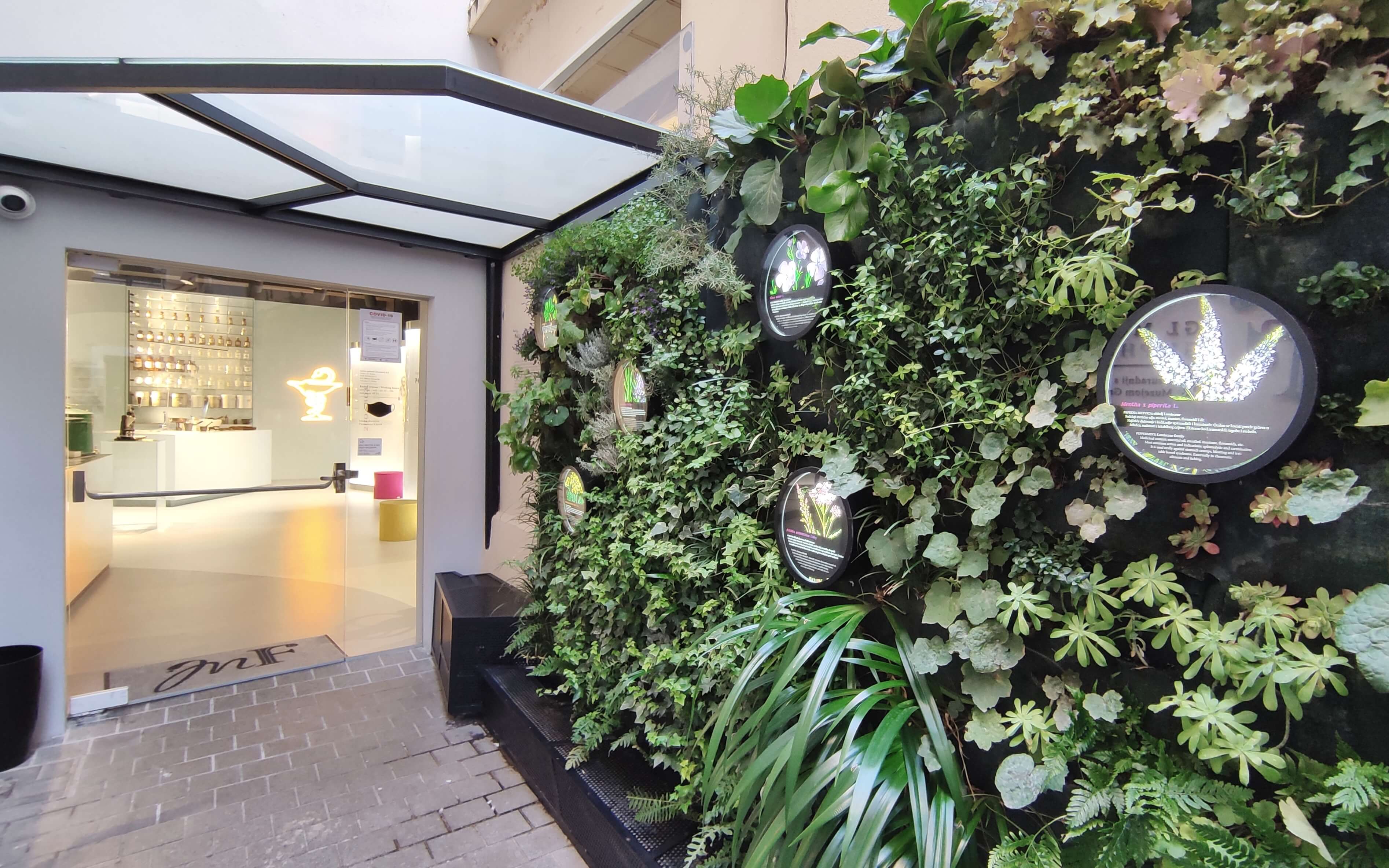
Inside, a sleek glass timeline snakes through the exhibition space and comes to life through AR, with distinguished individuals from the history of pharmacy telling their stories and teaching us a few interesting facts along the way.
You’d be perfectly fine just checking out the exhibits as the display is engaging enough as it is, but the AR points significantly add to the experience as they expand on the info presented on the panels, making the historical personalities more entertaining and lifelike - this will likely be a deciding factor if you’re visiting with kids. The AR guide is available in Croatian and English - pick up your tablet when purchasing tickets at the entrance.

Here are a few things we learned to spark your curiosity:
- The inventor of diazepam was born in Opatija, Croatia! Chemist Leo Henryk Sternbach invented the medicine first marketed as Valium in the early 1960s, after he’d moved to the US where he worked for Hoffmann-La Roche. By the end of the 60s, Valium became the top-selling medicine in the US. Sternbach soon retired but didn’t rest on his laurels, instead going on to work at the lab and mentor students for another 30 years.
- The Dalmatian town of Trogir was home to the oldest pharmacy in Croatia; the establishment was specifically mentioned as a pharmacy in historical records as early as 1271!
- The first monastic pharmacy soon followed: the Friars Minor pharmacy in the Franciscan monastery in Dubrovnik was founded in 1317. The Croatian Ministry of Culture placed the Dubrovnik pharmacy on the list of intangible cultural heritage in 2019.
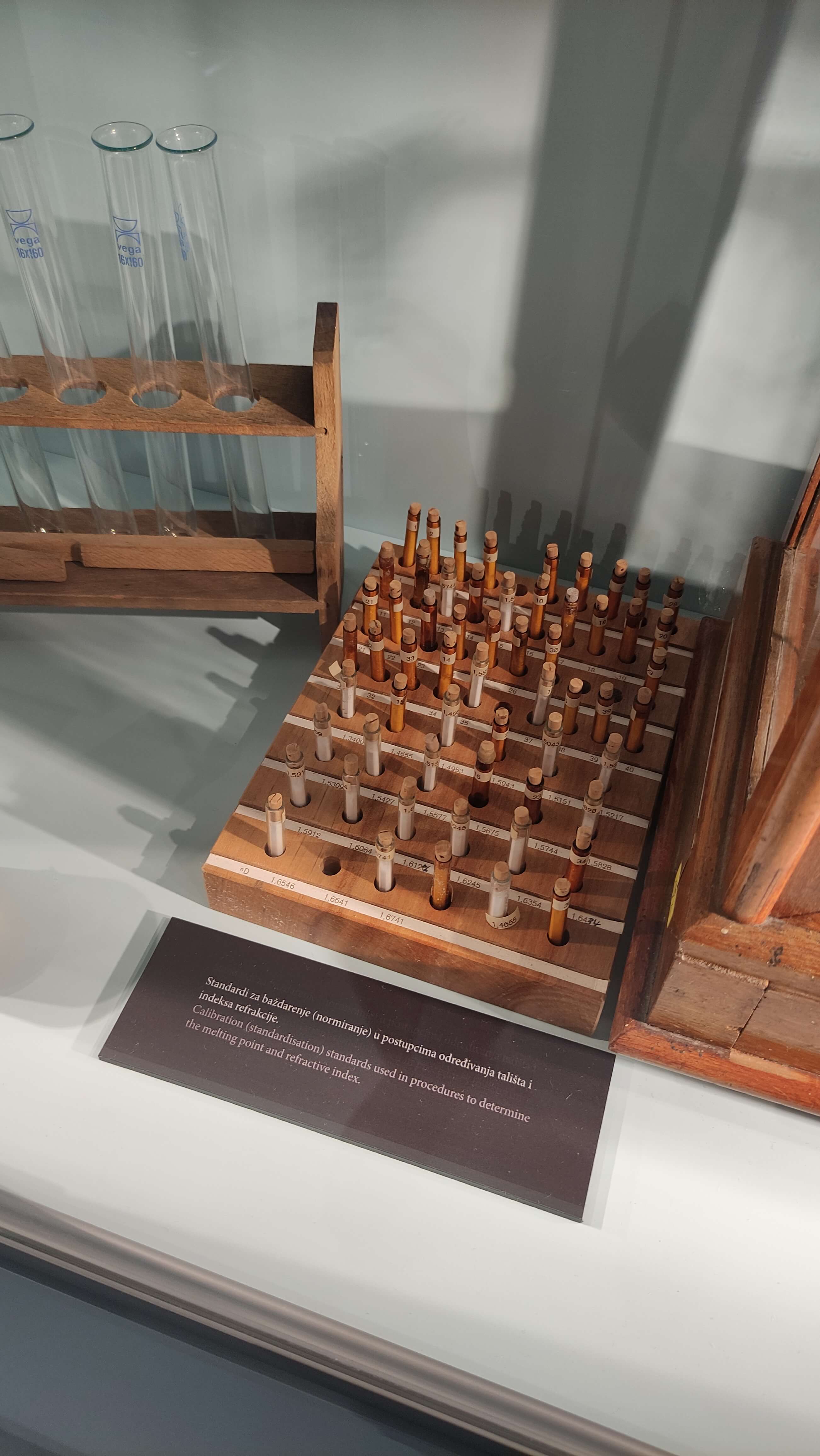
- Another nod to Dubrovnik as the first place in the world to introduce mandatory quarantine. In 1377, the Great Council of Dubrovnik passed a legislation that had all arrivals from areas ravaged by plague spend 30 days on Mrkan island before entering the city. (In comparison, today's isolation guidelines don't seem that harsh anymore.)
- Among the Nobel prize winners for chemistry are two Croats - a mentor and his protégé, Lavoslav Ružička and Vladimir Prelog. They were both involved in medicine development and won the Nobel prize in 1939 and 1975 respectively.
Hidden behind the timeline is the central exhibit, an impeccably recreated front-end space of a historic pharmacy (oficina) dating to the early 20th century.

Front-end spaces were intended for the reception of patients, as well as preparation and dispensing of medicine. The one displayed here was in operation until 2019 in the pharmacy ‘Kolodvor’ near the railway station in Rijeka and comes complete with a pharmaceutical balance and a vintage cash register.
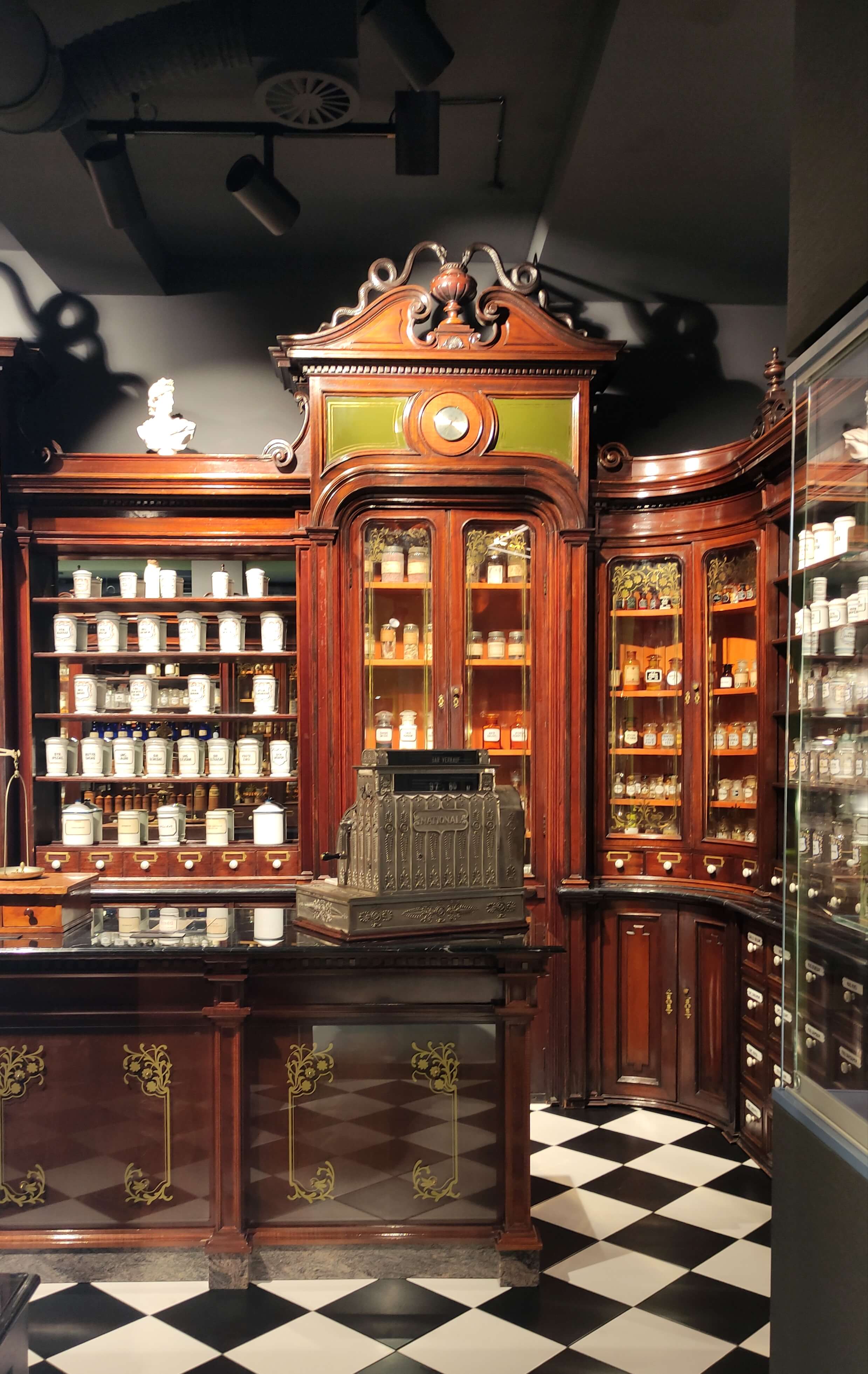
The exhibition gives us insight into local history as well, featuring two pharmaceutical companies from Rijeka, ‘Alga’ and ‘Ljekarna Jadran’. A pioneer not only in pharmaceuticals and cosmetics but in advertising as well, Alga was a marketing powerhouse and a household name in the interwar period. Their first product, named ‘Alga za masažu’ (massage algae), was made of natural extracts of native plants and was said to heal every malady from a toothache to influenza.
The ad below urges retailers to buy Alga in bulk and guarantees they’ll sell every single unit, or else they can return the unsold stock to the manufacturer:
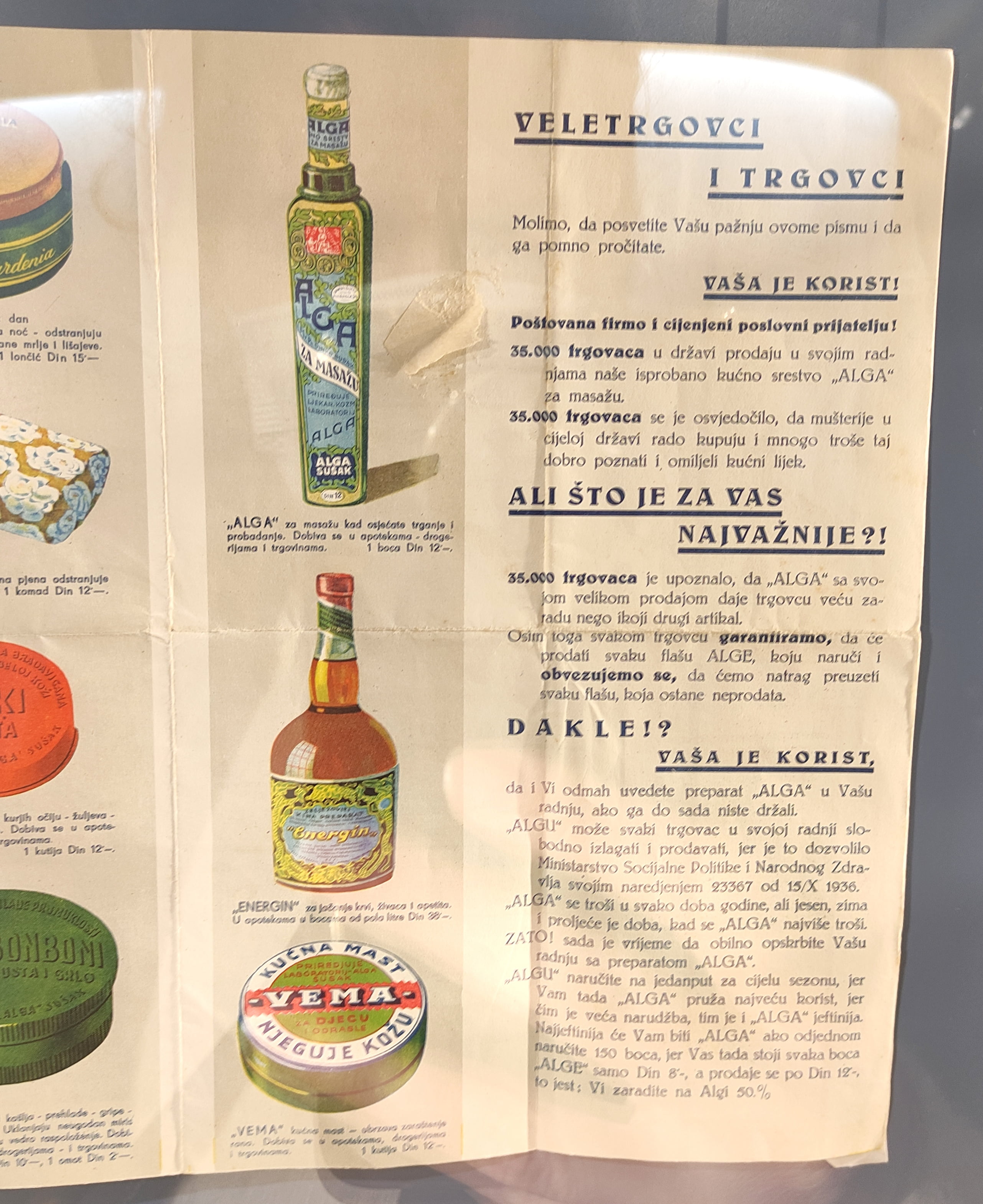
A section of the permanent exhibit is dedicated to medicinal herbs, including a modern twist on a herbarium and many cabinets and drawers to peek into:
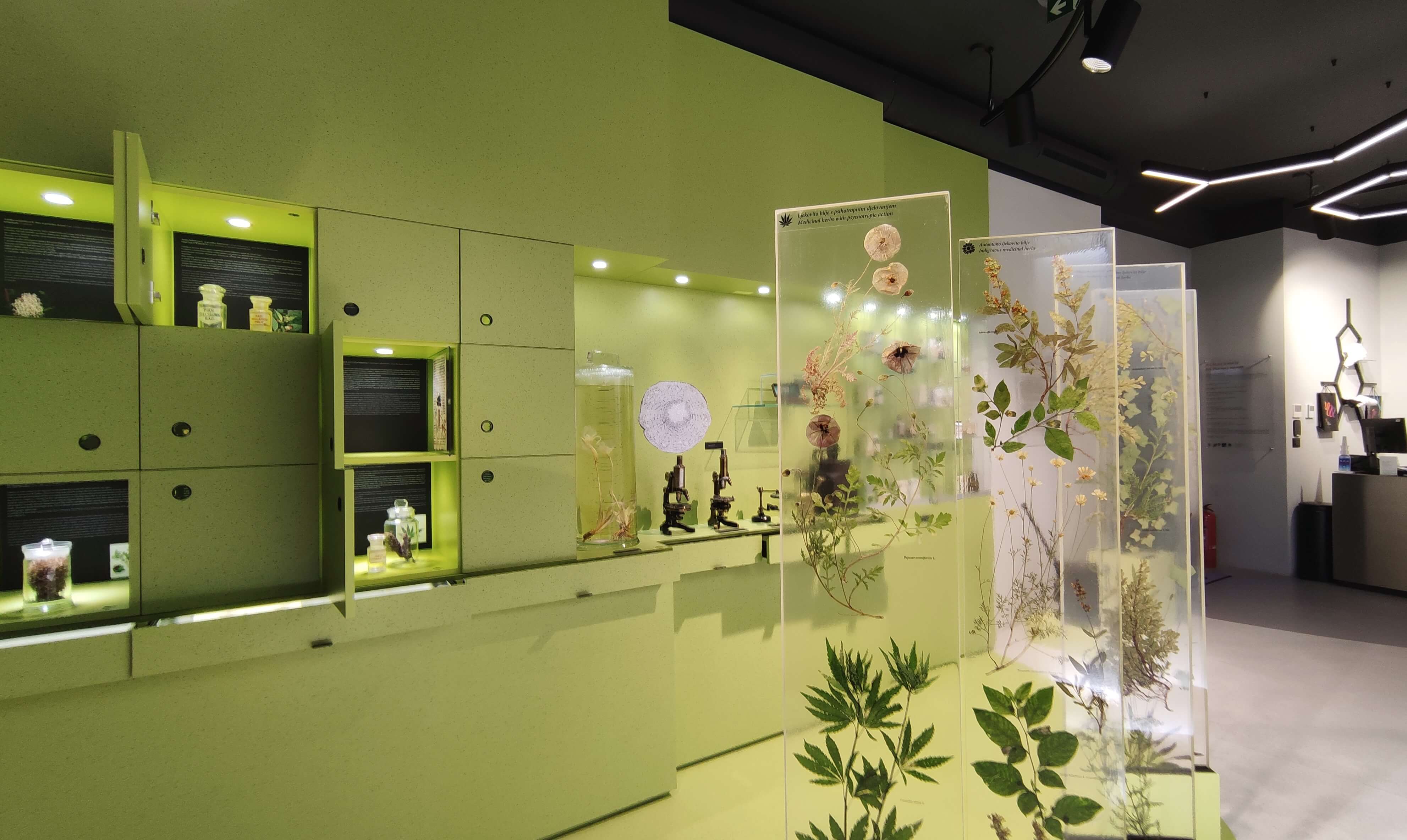
The entire display is superbly designed and allows the visitor to decide how much time and attention they want to dedicate to each exhibit; it doesn’t overwhelm with historical facts or scientific data, instead presenting information in an engaging and interactive way.
Indulge your obsession with historical curiosities and vintage bric-a-brac (just me?) and leave with a renewed appreciation for science. Overall, an excellent place to spend a Saturday afternoon.
Learn more about the JGL Pharmacy Museum on their website, and discover other attractions worth visiting in Rijeka in our guide here.
Meet Vukovar 365, Full of Life: Dario Hegeduš of TS Allegro
January 22, 2022 – Meet Dario Hegeduš, a multi-talented young man who is working hard on preserving Croatian heritage in the east through music.
If you’ve ever watched a promo video about Slavonia, it’s likely that you heard the sound of tamburica. This little instrument is a type of lute, with a small round body and a long neck. It is believed that it originated in Persia and by way of Turkey reached its home in eastern Croatia where it remains an integral part of a good time (or a way to drown your sorrow). From festivals and parties to weddings and funerals, the sound of tamburica will follow the journey of the Slavonian soul. Just like anything traditional, though, in modern times, it sits on the margins of the music scene. So, to the rescue come people like Dario.
As he says, Dario started devoting his free time to the art of music as soon as he grew strong enough to hold a tamburica. Now he counts more than 20 years of experience and numerous successes, be it professional, on the music scene, or private – all involving the tradition. He started his own tamburaški sastav – a music band playing tamburica music, as well as a tamburica orchestra of 27 members. He has travelled half the world showing off his skills and made some beautiful friendships on the way. Dario also works for the Vukovar Tourist Board’s marketing department, creating and sharing some outstanding material promoting this beautiful city.
How long have you been involved in music and where did your love for the tamburica come from?
I’ve been involved in music for a full 20 years. It started when I was 9 and I finally gathered the strength to press the strings on a tamburica. All of my family is quite musical – my parents dance in a traditional ensemble, my sister and brother dance and play musical instruments, so I didn't want to be the black sheep. I started playing tamburica, grateful that I can help preserve Croatian tradition and heritage.
You decided to start your own tamburica band. Tell us about it.
When my friend and I remained among the youngest members of the tamburica section in HKGD "Dunav" (HKGD stands for Croatian Cultural and Musical Society), we realized that we should show our friends that playing tamburica is no less "cool" than other hobbies. After persuading everyone we knew, we managed to get all of three other guys to rejuvenate the tamburica section a bit, and ended up forming a band. After a few years, the team grew, and now I also conduct an orchestra of 27 members.
What are your biggest successes?
I hope that the greatest successes are yet to come, but the first thing that came to mind was that I convinced this girl, a hip-hop rapper (now my wife), to become a lover of traditional music and that today she leads the children's dance section in HKGD "Dunav" in Vukovar.
As for awards, my favourites are those with my band and the orchestra, as being the national champion among many tamburica orchestras and representing Vukovar on the national and international scene is a true privilege.
What are all the possibilities open to you? Are you limited to eastern Croatia?
The music we play here is traditional Croatian and truly represents Eastern Slavonia and Srijem where we live. Traditional instruments are not so popular among the younger generations, but the tamburica and its great potential have found a place among young people. It is interesting to explore different types of music, from classical through rock, and of course traditional tunes, all in a tamburica version. Two tamburica studios have opened in Croatia, and the instrument is becoming popular in the rest of the world as well – as evidenced by our guest appearances and performances throughout Europe, in Canada, but also in China!
What are the best parts of your job in music?
Socializing and traveling, being part of a team creating the history of Vukovar through the preservation of tradition. This feeling makes me feel stronger and more enriched than anything else.
What are your hopes for the future?
I believe that the tamburica can become one of the reasons for tourists to visit our area, because of its uniqueness. It cannot be digitized, there is no virtual form, and combined with our cultural and natural heritage, the experience would enrich all travel itineraries.
Do you think that traditional music is sufficiently represented, how can we promote it?
It is sufficiently represented in the circles of our society through various festivals, events, media support, publishing houses, etc. The best promotion is to use the tamburica as an experience in our tourist offer. Imagine allowing every tourist to play their favorite song on an instrument they’re holding for the first time.
Apart from the fact that everyone in Vukovar knows you for your music, you work for the local tourist board. What is your job and what is the future of tourism in Vukovar?
I think that working for the tourist board goes hand in hand with the work I do in my free time. The PR, marketing, creativity, ideas, organization, acquisition of new skills and knowledge through working for the Tourist Board can be applied to music, and vice versa. The future of tourism in Vukovar looks bright, as evidenced by numerous analyzes of tourist arrivals and overnight stays, as well as cruiser arrivals. Cyclists, groups, and individuals who seek to explore cultural, sacral, natural heritage, memorial tourism, rich social content, gastronomic offer, etc. should all see Vukovar as the perfect destination.
What do you think about the Vukovar Card idea? Will our Tourist Board support this initiative?
The Vukovar Tourist Board supports any initiative that contributes to the development of Vukovar as a tourist destination as well its economy, and Vukovar Card is another good idea. Currently, the Vukovar Tourist Board in cooperation with IQM Destination utilizes a Welcome Card that connects our tourist entities and facilities and provides tourists with additional value while visiting our city. I believe that Vukovar Card could be one of the additional motivators for the arrival of foreign and domestic tourists.
Finally, tell us why everyone should visit Vukovar, what is the best thing here?
The best thing here is certainly the people. Everyone knows that we are the best hosts, and when you have a good host, your visit to Vukovar cannot be any less than the best! And Vukovar – visit it for yourself. Getting to know the city will emotionally drain you, but then fill you with pride and joy which will always bind you to it. You will always come back.
Let’s hear some of your music!
Check out our Facebook page where we share our music, successes, funny stories, and all you might want to know about us. For a soundtrack, go directly to our YouTube channel.
For more, check out our dedicated lifestyle section.
Croatian FM Attends Montenegrin Panel Debate on Croat Minority
ZAGREB, 22 Jan 2022 - Croatian Foreign and European Affairs Minister Gordan Grlić Radman on Saturday attended via video link a round table discussion on the minorities as bridges of cooperation between Croatia and Montenegro, which was held in Podgorica.
In his address to the conference, Grlić Radman said that Montenegro was on the right track to recognise its strength and values in diversities, the Croatian ministry stated in a press release.
"We have had and still have many outstanding issues concerning our cultural heritage. However, the agile work of the Croatian National Council in Montenegro, led by the council president Zvonimir Deković, in cooperation with us and Croatian institutions, finds ways to satisfy the fundamental customs to the mutual benefit of both countries," said the minister, citing examples of the ethnic Croat heritage in Montenegro such as the cult of St. Tryphon, the tradition of the Croatian fraternity Bokeljska Mornarica, and local Marian shrines and so on.
For more, check out our dedicated politics section.
Culture Ministry Allocates €533k for Visual Arts and €252k for Translations
ZAGREB, 22 Jan 2022 - The Ministry of Culture and Media has granted support for the promotion of visual arts in the total amount of HRK 4.035 million (€533,000).
A total of 338 applications were submitted to the call for financing public needs in culture in 2022 for the scheme of financial support and 214 of them have been selected.
The ministry also approved HRK 1.89 million (€252,000) scheme for literary creative processes, including translations of great works into Croatian. As many as 72 projects will be funded under this scheme.
(€1 = HRK 7.5)
For more, check out our dedicated politics section.
Minister Medved: Operation Maslenica Showed Our Ability to Free Homeland
ZAGREB, 22 Jan 2022 - Croatian War Veterans' Affairs Minister Tomo Medved said on Saturday that the Operation Maslenica in 1993 was a turning point in the Homeland War and that it had sent a strong message of the capability of the Croatian armed forces to free their country from the enemy.
Addressing the central ceremony marking the 29th anniversary of the Operation Maslenica in Zadar, the minister expressed gratitude to the participants in the operation and particularly to the families who lost their members in that liberating action.
Operation Maslenica was launched in the early morning hours of 22 January 1993, with Croatian forces regaining control of the Serb-occupied Zadar hinterland, the straight of Maslenica, the Zemunik airbase and later on the Peruca dam. Within 72 hours, nearly 100 square kilometres of occupied territory was liberated. Croatian forces regained control of key strategic points from Serb insurgents and re-established transport connections between the country's north and south. In the first three days of the operation, 19 Croatian soldiers were killed and 70 were wounded. However, by 31 March 1993 the number of Croatian fatalities rose to 127 as Serb forces fought back.
Minister Medved said that the Operation Maslenica sent a strong message that the Croatian armed forces and police were capable of liberating every occupied inch of the occupied territory, as it was later shown in the military and police operations in 1995.
Medved also pointed out the importance of commemorating this operation and other events from the 1991-1995 Homeland War as a reminder that freedom in the present-day Croatia should not be taken for granted and that the defenders and the Homeland War were the strongest pillar of the independent and sovereign Republic of Croatia.
For more, check out our dedicated politics section.
Orthodox Fresco Depicting Blessed Stepinac in Hell Painted Over by White
ZAGREB, 22 Jan 2022 - An icon, which appeared in a Serb Orthodox Church in the town of Bela Crkva, Vojvodina, depicting the Blessed Alojzije Stepinac, a Catholic martyr, in the hell, has been painted over by white, the Croatian Catholic news agency IKA reported on Friday.
IKA quoted the Zrenjanin Catholic Bishop Ladislav Német as saying that the controversial icon was painted over by white and that news items about Bela Crkva and the icon depicting Stepinac in the hell were no longer topical.
The news about the controversial fresco was broken by the direktno.hr news website on 16 January. The fresco depicting the hell and the Blessed Stepinac in it was painted on a wall of the Serb Orthodox Church of Saint John in Bela Crkva, a town in the region of Banat, which is in the eastern parts of the Serbian province of Vojvodina.
The whole case prompted the Catholic Archbishop of Belgrade, Stanislav Hočevar, to say that depicting a saint in the hell was an insult to God.
He told the Croatian national broadcaster (HRT) that he would try to solve this issue through dialogue.
He also apologised to the Catholic faithful in Croatia for the belated reaction of the Catholic Church in Vojvodina and Serbia to this case.
Archbishop Hočevar said that this would be also a topic of his talks with the Apostolic Nuncio in Serbia on Saturday.
Pope John Paul II declared Alojzije Stepinac a martyr and beatified him at a ceremony in the Croatian Marian shrine of Marija Bistrica in 1998, when hundreds of thousands of Croatians gathered for that mass.
Later, Pope Francis decided to initiate the establishment of a joint commission to study the historical truth on Croatian Cardinal Alojzije Stepinac and to shed light on the historical role of this Zagreb Archbishop at the time of the WWII Independent State of Croatia (NDH) and the Ustasha crimes in the Jasenovac concentration camp, before the decision on his canonisation.
After the Second World War, Stepinac was persecuted by the Communist authorities in the Tito-led Yugoslavia. In 1945 he declined Tito's proposal to establish a national Catholic church separate from Rome.
In July 2016, Zagreb County Court annulled the Communist-era rulings against Zagreb Archbishop Alojzije Stepinac, who was sentenced in 1946 to 16 years in prison and forced labour and was stripped of his political and civil rights for five years.
Zagreb County Court established that the guilty verdict had grossly violated the then and the current principles of the criminal law.
Cardinal Stepinac (1898-1960) was the leading person of the Catholic Church in Croatia during World War Two. After the war, Communist authorities charged him with collaborating with the Ustasha regime of the Independent State of Croatia (1941-1945), although he publicly denounced the crimes of the pro-Nazi regime and actively helped provide sanctuary for those persecuted. Subsequently, Stepinac spent five years in prison and nine years under house arrest until he died.
In October 1946 the then Supreme Court found him guilty of all charges in his indictment.
In February 1992, the Croatian parliament adopted the declaration condemning the court decision and the process that led to it. The declaration states that the true reason of Stepinac's imprisonment was his pointing out many Communist crimes and especially refusing to form a Croatian Catholic Church in schism with the Pope.
For more, check out our dedicated politics section.
Immunologist Says It's Still Too Early to Ease Anti-epidemic Rules
ZAGREB, 22 Jan 2022 - Immunologist Zlatko Trobonjača, a professor at the Faculty of Medicine in Rijeka, said on Friday that although the Omicron variant of the virus seemed to cause milder symptoms of COVID-19 than previous variants, it was still to early to relax anti-epidemic restrictions.
Calling for caution, the doctor said in his interview with the national broadcaster (HTV), that there had been nearly 17,000 new daily cases of the infection on Friday, while the hospital admission numbers had fallen to some extent.
He explained that the new variant mostly infects the upper respiratory tract and therefore it spreads faster, while, on the other side, it seems to be causing milder symptoms of the disease.
Trobonjača went on to say that the Omicron epidemic has been lasting just about 20 days, and that it is a short period to make conclusions whether this variant of the virus is not dangerous.
We must wait for some time and see what consequences the spread of the Omicron can produce for health, before giving a thought to the relaxation of the restrictions, the professor said.
The level of the collective immunity which is being acquired through vaccination, immunisation and also through recovery from the disease will put an end to this virus eventually, he said.
For all you need to know about coronavirus specific to Croatia, make sure to bookmark our dedicated section and select your preferred language if it isn't English.
Seventh Edition of WineOS Kicks Off on Thursday, Full Schedule Announced
January 22, 2022 - After its cancellation in 2021, due to the epidemiological situation, the seventh edition of WineOS will be held on 28 and 29 January 2022, in Osijek's Gradski vrt hall, with an extensive program that includes workshops led by wine masters, tasting of the best regional and international wines, and much more.
The seventh edition of WineOs wine fair will be held on January 28 and 29, 2022 (Friday and Saturday). Due to the great interest of exhibitors and visitors, and with the desire to further increase the attractiveness, the fair this year was located in the Sports Hall Gradski Vrt, Kneza Trpimira 23, Osijek where a large number of leading wine producers from all regions of Croatia and neighboring countries to embark on discovering new wine experiences.

The seventh edition of WineOS will present and taste wines, hold seminars and educational workshops for business people, traders, sommeliers, caterers, journalists, and all wine lovers.
"At more than 1,900 square meters, we have 90 exhibition spaces and more than a hundred exhibitors. In addition, we will once again be able to watch a culinary show on stage where specialties will be prepared by four top local chefs, recognizable wine workshops will be held in a separate space, and the day before the fair, on January 27th, a gala dinner will be held at Waldinger Restaurant, which will be taken care of by our famous chef Goran Kočiš", said the president of the Decanter, Boris Ocić.
"There is great interest in wine workshops. Even before we officially announced the program, interested parties came forward and all the places were quickly filled. The lucky ones who managed to get a ticket will once again have the opportunity to taste numerous exclusives represented by famous winemakers from Croatia, Hungary, Austria, Serbia, and Bosnia and Herzegovina", said the head of the workshop program Željko Garmaz.
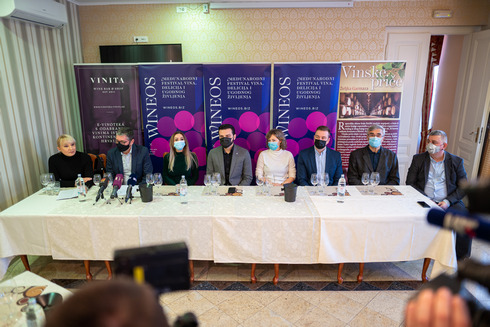
The association Graševina Croatica rejoined the organization as the largest and most important organization of wine producers in eastern Croatia. "WineOS is the central event for this wine region and is moving in the direction of transformation into the largest and most important fair in Croatia and the entire region. We will wholeheartedly help the organizers along the way. This year, as usual, we put the emphasis on Graševina as the broadest, most economically important, but also the most potent variety of this region'', Pavić added.
The organizers of the seventh edition of WineOS agreed on a greater engagement with the Osijek School of Catering and Tourism, which in this event recognized the opportunity for additional education of students and promotion of programs and projects. "Our students regularly go through internships in catering facilities, and this is an opportunity for them to learn how to work at big events. We have invested a lot in improving the program, additionally trained lecturers and mentors and now we want to apply it in the learning process", said the director of the School of Catering and Tourism Andrej Kristek.
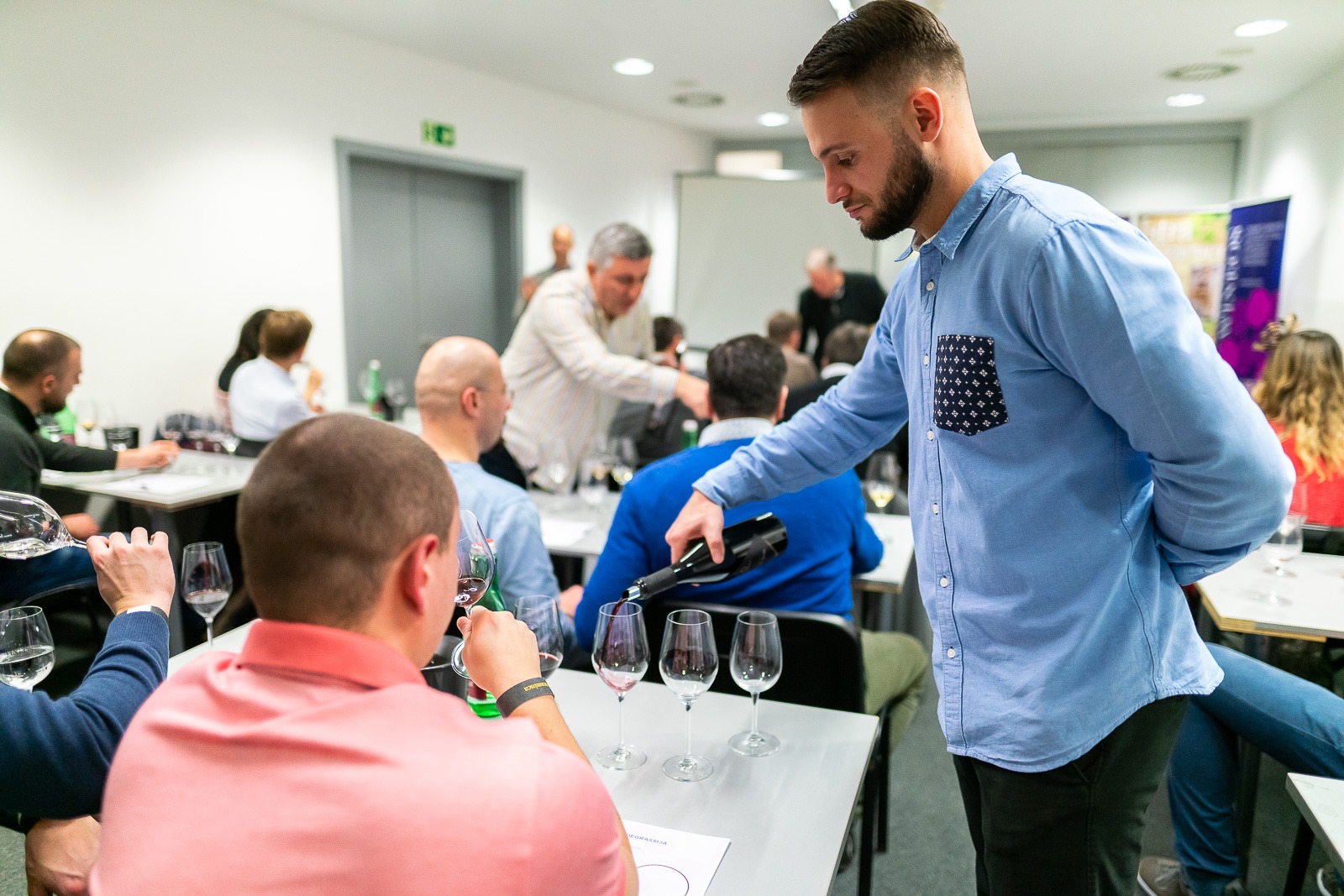
Photo: Denis Despot
"Wine events are attracting more and more guests to the continental regions, and the events we have in our county are becoming a recognizable lure for domestic guests and tourists", said the director of the Osijek-Baranja County Tourist Board, Ivana Jurić. She emphasizes that WineOS, as one of the largest events of this type, is already well known throughout Croatia and neighboring countries. Therefore, supporting this event, she says, is a logical and simple choice.
"It is not difficult to support such an event, which has grown seriously in recent years in every sense. More and more good and positive stories are coming out of Osijek, and WineOS is one of them. Despite the difficult times, the organizers made an effort to make our city a real wine center once again. Therefore, I wish them good luck with the message that the city administration is always ready to support quality projects", commented the Deputy Mayor of the City of Osijek, Dragan Vulin.
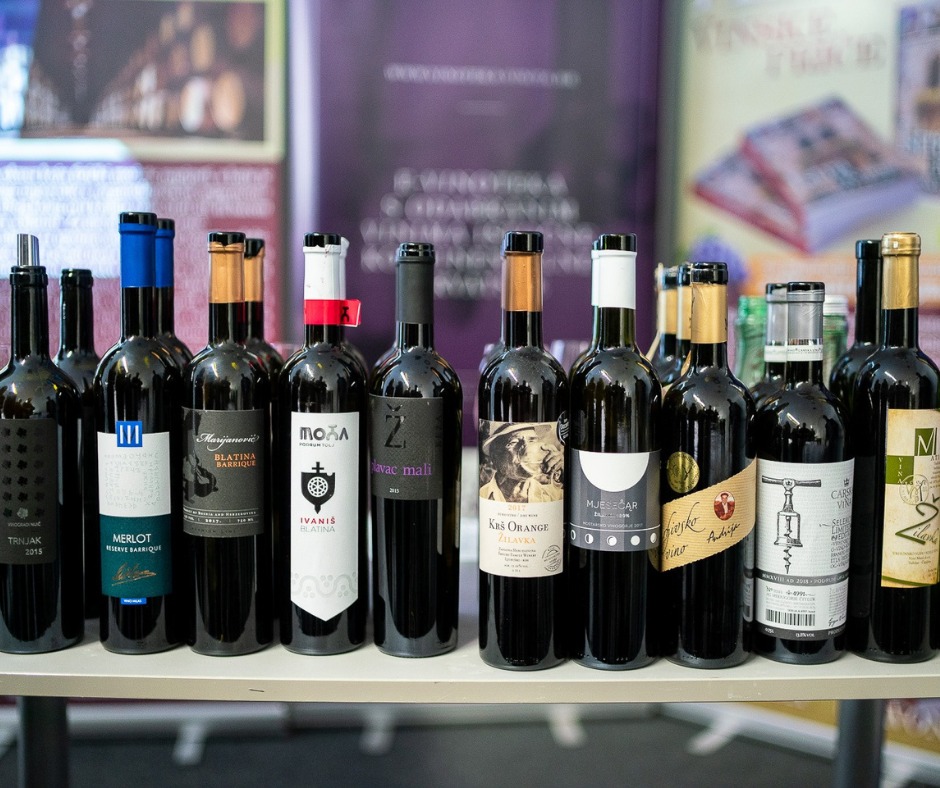
Photo: Denis Despot
The Head of the Administrative Department for Tourism, Culture, and Sports, Tatjana Roth, addressed the audience on behalf of Osijek-Baranja County. "Wine and gastro tourism attract many guests, and we do not lack offers. WineOS is extremely important in the promotion of this segment and we were certainly happy to get involved in this story as sponsors. I am sure that the fair will fulfill its purpose in these challenging times and bring a lot of work to wine and delicacies producers".
The seventh edition of WineOS will be held on both days from 3 to 9 p.m. It will only be able to enter the hall upon the presentation of a valid COVID certificate or negative test. Tickets will be sold exclusively at the hall entrance at a price of 100 kuna for one festival day. Visitors will also be able to rent a festival glass at the entrance.
Anyone who does not have a COVID certificate and wants to visit WineOS will be able to do by testing in the medical office of Dr. Špiranović, at 54 Stjepana Radića Street, at a preferential price of HRK 50. The clinic will be open from 8:00 am to 3:00 pm on January 28 and from 8:00 am to 12:00 pm on January 29.
It should also be noted that after the press conference, a wine workshop was held and led by the famous master sommelier Eric Zwiebel. On that occasion, those present were able to taste 13 Graševina from five vineyards in eastern Croatia, and the distinguished guests pointed out the good potential of the variety that stylistically fits into current market trends. Tonight, Zwiebel will hold another workshop to present Riesling wines from the French region of Alsace.
Here's the complete schedule for the seventh edition of WineOS:
- Thursday, January 27, 2022 - Gala dinner "SLAVONIA ON A PLATE AND IN A GLASS" by Goran Kočiš and Graševina Croatica
Time: 7:30 pm
Location: Hotel Waldinger
Entrance: 400 kuna
Menu:
Duck liver torchon / brioche / black walnut
Beetroot risotto / blue cheese
Catfish / holandaise / black pig
Rabbit ravioli / parsley
Deer / red cabbage / chestnut
Bags / plum / cream
- Friday, January 28, 2022 - Workshops
14:00 pm - Sauska - Hungarian wine giant with cover; entrance 100 kn
15:30 pm - Michael Gross - Austrian wine prodigy who brings glory to Slovenia with his wines; entrance 150 kn
17:00 pm - Josić Winery - Croatia Baranja fights back to Villany, and we have Cabernet Franc for the race; entrance 100 kn
18:00 pm - Luka Krajančić - Great vertical of Intrade, the most important white wine in Dalmatia; entrance 150 kn
Daily ticket for all workshops: 400 kn
- Saturday, January 29, 2022 - Workshops
14:00 pm - Vlado Krauthaker - The Wonderful World of Graševina, entrance 150 kn
15:30 pm - Grabovac Winery - Blue Lake Riserva, Dalmatian "Superzagorac", entrance 100 kn
17:00 pm - Božo Aleksandrović - Pedigree, the best wine in Serbia, entrance 100 kn
18:30 pm - Josip Brkić - Good Bye, Limousine!, entrance 150 kn
Daily ticket for all workshops 400 kn
Source: Osijek 031, Vinske Priče
Croatian wines and grapes are among the best in the world, and you can find more information about them in Total Croatia’s Guide to Croatian Wine HERE.
For more on lifestyle, follow TCN's dedicated page.
Filip Hrgović Awaits Yet Another Opponent as Tony Yoka Withdraws from IBF Final Eliminator
January 22, 2022 - It has been a whirlwind of unfortunate events for Croatian boxer Filip Hrgović, who now waits for yet another new opponent in the IBF Final Eliminator.
It's been quite the last few weeks for Croatian boxer Filip Hrgović. After Tony Yoka accepted Hrgović's offer for a big rematch, on Friday morning it was confirmed that there will be no fight, reports Boxing Scene and Gol.hr.
The IBF ruled in favor of an appeal filed by Martin Bakole who rebelled because he felt Tony Yoka owed him a fight. He and Yoka were due in the ring in December in France, but that fight was postponed due to the pandemic. Since the French fighter owes him a fight, Yoka cannot make a deal with any other fighter.
Martin Bakole's lawyers provided evidence confirming that the fight was only postponed to April this year and not completely canceled as claimed by the Yoko team.
This means that the IBF is searching for a new opponent for Filip Hrgović, who was previously rejected by Luis Ortiz and Joseph Parker.
Joe Joyce is expected to be next on the list, but he is still recovering from his injury. If he refuses the invitation, the IBF could contact Agit Kabayel, and next on the list is Chinese boxer Zhilei Zhang, who has already spoken publicly about the fight with the Croatian boxer and who again seems to be the most realistic opponent.
For now, Hrgović and his team will wait for one of the mentioned boxers to accept the IBF invitation. The boxers have three days to respond to the offer, followed by negotiations.
The winner of that fight will wait for the outcome of the upcoming rematch between Oleksandr Usik and Anthony Joshua, which should take place in the spring.
To read more about sport in Croatia, follow TCN’s dedicated page.


